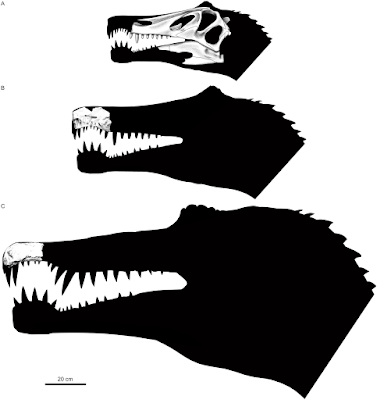Abstract
Fossil sites from Brazil have yielded specimens of spinosaurid theropods, among which the most informative include the cranial remains of Irritator, Angaturama, and Oxalaia. In this work some of their craniodental features are reinterpreted, providing new data for taxonomic and evolutionary issues concerning this particular clade of dinosaurs. The mesial-most tooth of the left maxilla of the holotype of Irritator is regarded as representing the third tooth position, which is also preserved in the holotype of Angaturama. Thus, both specimens cannot belong to the same individual, contrary to previous assumptions, although they could have been the same taxon. In addition, the position of the external nares of Irritator is more comparable to those of Baryonyx and Suchomimus instead of other spinosaurine spinosaurids. In fact, with regards to some craniodental features, Brazilian taxa represent intermediate conditions between Baryonychinae and Spinosaurinae. Such a scenario is corroborated by our cladistic results, which also leave open the possibility of the former subfamily being non-monophyletic. Furthermore, the differences between spinosaurids regarding the position and size of the external nares might be related to distinct feeding habits and degrees of reliance on olfaction. Other issues concerning the evolution and taxonomy of Spinosauridae require descriptions of additional material for their clarification.
Final remarks
Spinosaurid dinosaurs have been surrounded by an enigmatic atmosphere due to their bizarre anatomy and morphology as well as the fragmentary nature of most collected specimens. The tragic loss of the holotype of Spinosaurus aegyptiacus also contributed to this condition. Despite being incomplete, spinosaurid cranial remains from Brazil are informative in multiple ways and help fill in some gaps in the knowledge on these theropods. The reinterpretation of certain craniodental features supports, for example, the distinction between Irritator and Angaturama at least at the individual level, and our cladistic results indicate the latter taxon and Oxalaia as successive outgroups of MSNM V4047. In addition, the evolution of spinosaurid craniodental features is likely related to different trends towards semiaquatic and/or piscivorous habits. These trends might have had a major impact on the position and size of the external nares, suggesting the reduction of the importance of olfaction in relation to other senses during foraging. However, other issues remain more disputable, such as the possible non-monophyly of Baryonychinae, the possible synonymy between the Araripe spinosaurids, and the sequence of morphological changes during the evolutionary history of Spinosauridae. Further study is needed to address these issues, including the formal description of additional cranial and postcranial remains. In this sense, although African materials are usually the focus of most investigations, Brazilian specimens play an important role in discussions concerning the evolution and paleobiology of Spinosauridae. This statement is clearly corroborated by new findings of these dinosaurs in understudied fossil sites.
Marcos A. F. Sales and Cesar L. Schultz. 2017. Spinosaur Taxonomy and Evolution of Craniodental Features: Evidence from Brazil. PLoS ONE. 12(11); e0187070. DOI: 10.1371/journal.pone.0187070



